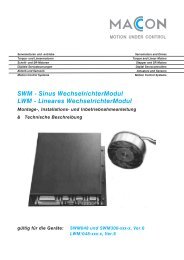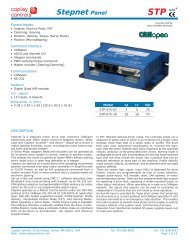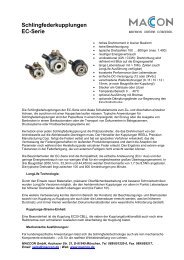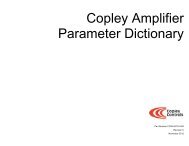CANopen Programmer's Manual - Maccon.de
CANopen Programmer's Manual - Maccon.de
CANopen Programmer's Manual - Maccon.de
Create successful ePaper yourself
Turn your PDF publications into a flip-book with our unique Google optimized e-Paper software.
2: Network Management <strong>CANopen</strong> Programmer’s <strong>Manual</strong><br />
Device Monitoring<br />
Monitoring Protocols<br />
In addition to controlling state machines, NMT messages provi<strong>de</strong> services for monitoring <strong>de</strong>vices<br />
on the network. Monitoring services use one of two protocols: heartbeat and no<strong>de</strong> guarding.<br />
Heartbeat Protocol<br />
The heartbeat protocol allows the network manager application to <strong>de</strong>tect problems with a <strong>de</strong>vice<br />
or its network connection. The <strong>CANopen</strong> master configures the <strong>de</strong>vice to periodically transmit a<br />
heartbeat message indicating the <strong>de</strong>vice’s current state (pre-operational, operational, or stopped).<br />
The network manager monitors the heartbeat messages. Failure to receive a no<strong>de</strong>’s heartbeat<br />
messages indicates a problem with the <strong>de</strong>vice or its connection to the network.<br />
No<strong>de</strong>-guarding Protocol<br />
The no<strong>de</strong>-guarding protocol is similar to the heartbeat, but it allows both the <strong>de</strong>vice and the<br />
network manager to monitor the connection between them. The network manager configures the<br />
<strong>de</strong>vice (no<strong>de</strong>) to expect no<strong>de</strong>-guarding messages at some interval. The network manager then<br />
sends a message to the configured <strong>de</strong>vice at that frequency, and the <strong>de</strong>vice responds with a<br />
no<strong>de</strong>-guarding message. This allows both the network manager and the <strong>de</strong>vice to i<strong>de</strong>ntify a<br />
network failure if the guarding messages stop.<br />
SYNC and High-resolution Time Stamp Messages<br />
The SYNC message is a standard <strong>CANopen</strong> message used to synchronize multiple <strong>de</strong>vices and<br />
to trigger the synchronous transmission of PDOs.<br />
In addition, to allow more accurate synchronization of <strong>de</strong>vice clocks, Copley Controls <strong>CANopen</strong><br />
amplifiers use the optional high-resolution time stamp message specified in the Communication<br />
Profile.<br />
Normally, a single <strong>de</strong>vice produces both the SYNC message and the high-resolution time stamp<br />
message. Copley amplifiers can produce the SYNC and high-resolution time stamp messages.<br />
We recommend using an amplifier as the master sync generator. This assures greater timing<br />
accuracy and allows the amplifier PVT segment buffer to be filled with the minimum number of<br />
PVT segments at all times during operation.<br />
Time Stamp PDOs<br />
The <strong>de</strong>vice <strong>de</strong>signated as the time stamp producer should have a transmit PDO mapped for the<br />
high-resolution time stamp message. This PDO should be configured for synchronous<br />
transmission, based on the SYNC message. We recommend sending this message approximately<br />
every 100 milliseconds.<br />
Every other <strong>de</strong>vice (all time stamp consumers) should have a receive PDO mapped for the highresolution<br />
time stamp message. The message ID of each receive PDO used to receive a time<br />
stamp should match the ID of the transmit PDO used to send the time stamp.<br />
Configuring the <strong>de</strong>vices in this fashion causes the time stamp producer to generate a transmit<br />
PDO for every N sync messages. This PDO is received by each of the time stamp consumers on<br />
the network and causes them to update their internal system times based on the message<br />
content. The result is that all <strong>de</strong>vices on the network act as though they share the same clock<br />
input, and remain tightly synchronized.<br />
Emergency Messages<br />
A <strong>de</strong>vice sends an 8-byte emergency message (EMCY) when an error occurs in the <strong>de</strong>vice. It<br />
contains information about the error type, and Copley-specific information. A <strong>de</strong>vice need only<br />
send one EMCY message per event. Any <strong>de</strong>vice can be configured to accept EMCY messages.<br />
42 Copley Controls
















